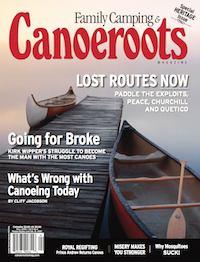When making the turn off the Trans-Canada Highway towards Burgeo, the picturesque village on the southwest tip of Newfoundland and the gateway to Sandbanks Provincial Park, the sign reads, “Fill your gas tank.” Heed the warning; the next pump is at the end of the road, and between you and it lays 150 kilometres of nothing; but nothing has never looked so good.
A SENSE OF ADVENTURE
You can’t help being overtaken by a sense of adventure as you make the turn down that long lonely road toward Sandbanks Provincial Park. The tunnel of trees lining the road gives way to green tundra-covered hills that roll off into the distance in a cascade of stacked ridges fading to grey; boulder-strewn river beds dip beneath the road and smooth dark-water ponds beg for the graceful arc of a fly-tipped line.
It’s a long drive to a park with only 25 camping sites that does not accept reservations. However being more than two hours off the beaten path, there are typically sites available, except during the annual Sand and Sea Festival always held the last weekend of July. This celebration of local music and culture brings revellers from far and near to partake in outdoor dances, a local food fair, games for young and not so young and of course the constant beat of East Coast music.
There has been plenty of dancing on the beaches of Sandbanks over the centuries. Archeological evidence on Sandbanks Island indicates that the Dorset Eskimo were the first inhabitants in the area. Next to visit was Sir Humphrey in 1583 and by 1628 the Portuguese were fishing the waters off the “Virgio Island.” The Anglican population arrived from England in the late 1700s and settled on the ground which is now Sandbanks Provincial Park. Later the settlement was moved to the site now known as Burgeo, to take advantage of the sheltered waters for their fishing boats.
FIRST IMPRESSIONS
The first impression upon arriving at Sandbanks Provincial Park is, WOW! Seven kilometres of white sand beach left behind by glacier deposits stretches as far as you can see. A wall of sand dunes frames the beach and the whole fragile structure is bound together by a thick carpet of dune grass and beach pea swaying in the breeze. Lapping at the sand is an expanse of water so blue it begs you to a swim. It is a landscape from a land much, much farther south, perhaps North Carolina, except that your ankles go numb before your knees get wet. After all this is the Atlantic Ocean and you are swimming at the latitude of James Bay with a local climate resembling southern Siberia. You have to be a brave soul to dunk your head here, a deed reserved for the bravest among us, meaning those 14 years of age and younger. The rest of us can settle for a dip at the roped-off swimming area on the much shallower, warmer, freshwater swimming pond.
Whatever your vacationing pleasure, Sandbanks and surrounding area has much more nothing than the road sign would suggest. An afternoon drive is really nothing to a place where surf pounds, music plays and kids dance on the beach; where morning mist rolls in over rocky islands and the water sparkles blue. Where quiet walks through the streets of Burgeo end in a tasty plateful of fresh fish and chips; a place that is guaranteed to fill your photo album with warm memo- ries and spectacular images.
But remember, fill your tank. The next pump is at the end of the road and after 150 kilometres of, well you know…




